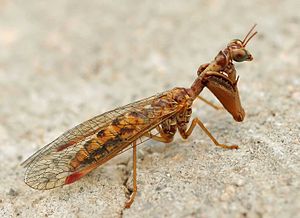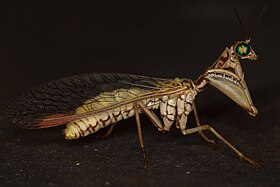Catchy
| Catchy | ||||||||||||
|---|---|---|---|---|---|---|---|---|---|---|---|---|

|
||||||||||||
| Systematics | ||||||||||||
|
||||||||||||
| Scientific name | ||||||||||||
| Mantispidae | ||||||||||||
| Leach , 1815 |
The captive (Mantispidae) are a family of the reticulated winged winged (Neuroptera). They occur worldwide with about 400 kinds, in Europe only five kinds are native in two genera, of which two kinds, Mantispa styriaca and Mantispa aphavexelte , live in Central Europe . Another species was newly described from Spain in 2014. Their main distribution area are the tropics and subtropics . The closest relatives are the Berothidae and the Dilaridae .
features
The captive reach a wing length of 5 to 30 millimeters with a body length of 5 to 47 millimeters. Their basic color is green, brown, yellow and sometimes reddish. They have a very peculiar body shape that a strong resemblance to mantis has (Mantodea). The prothorax is long and thin and movable. At its end, just behind the head, sits the first pair of legs , which, like the terrors, are formed into catch legs. In these animals, however, the fangs sit at the end of the prothorax. The hip (coxa) of such a leg is significantly elongated. It is followed by the flattened thigh (femur) with thorns on one side. The splint (tibia) and foot (tarsus) can be folded in towards the thorns of the thighs to catch prey. The triangular head is very similar to that of fishing horrors, especially due to the large, laterally strongly protruding compound eyes . The antennae are very short. The two pairs of wings are typically reticulated and mostly clear, only slightly darkened in some species. A clearly visible wing mark can be seen on the front edge. Because the first pair of legs sits far in front of the body, the animals only stand on the other two pairs of legs. The body is more or less narrowed between the thorax and the abdomen .
There are some species that mimic ( mimicry ) wasps , such as: B. Climaciella brunnea .
Way of life
There are both nocturnal and diurnal species, some of the former being attracted by artificial light sources. They live predatory on other insects, which they also actively hunt. But their flight characteristics are bad.
The eggs are stalked, small and green, and are laid in groups. A female can lay up to 8,000 of them. The larvae that hatch from it live as parasitoids on various insect larvae (especially bees and wasps ) and spider eggs . They develop hypermetamorphically , i.e. they change their shape fundamentally during their development. The larvae, which are well mobile at the beginning and have antennae and legs, only have stump legs, a small head and mouthparts in the second and third instar and look like maggots . In the first stage they do not ingest food. Only from the second stage do they live parasitically.
Fossils
The oldest fossil evidence for the existence of captives is a 44 million year old inclusion in Baltic amber . The larva was trapped along with the spider that attacked it. At the same time, the find is proof that catching larvae used the same strategies to acquire food as they do today.
Systematics (Europe)
- Mantispa aphavexelte U. & H. Aspöck, 1994
- Mantispa incorrupta Monserrat, 2014
- Mantispa perla Pallas, 1772
- Mantispa scabricollis McLachlan, 1875
- Mantispa styriaca (Poda, 1761)
- Nampista auriventris (Guerin-Méneville, 1838)
credentials
- ↑ Mantispidae. Fauna Europaea, accessed March 15, 2017 .
- ^ Michael Ohl: Aboard a spider — a complex developmental strategy fossilized in amber . Natural Sciences 98, pp. 453–456 (2011). ( English ) on: SpringerLink . Summary in: The enemy on the neck. Image of science . Edition 06/2011. Konradin Medien GmbH, Leinfelden-Echterdingen. ISSN 0006-2375
- ↑ Víctor J. Monserrat (2014): Los Mantíspidos de la Península Ibérica y Baleares (Insecta, Neuropterida, Mantispidae). Graellsia, 70 (2): e012. doi : 10.3989 / graellsia.2014.v70.115
literature
- E. Wachmann , C. Saure: Netzflügler, mud and camel neck flies, observation, way of life , Naturbuch Verlag, Augsburg, 1997, ISBN 3-89440-222-9

